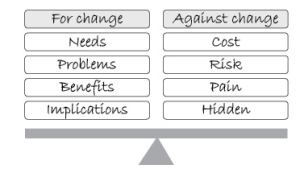The following is an extract from my new book ‘How to get Fired at the C-Level: Why mismanaging change is the biggest risk of all’ in association with my friends at Tailwind Project Solutions – previous extracts followed a series of 5 Challenges that I think every organisation should consider, and consider very carefully – and now we will look at the 5 tests of control:
We have already identified in an earlier article that knowing the true value of your investment in change, and the consequential cost of failure to deliver this change is critical.
On that basis now is the time for you to ‘do the math’ and work your change portfolio investment out, an example was covered in ‘Challenge 1 – Invest in the right portfolio management’ – so you can reference that if you wish.
Before you start how big do you think your Portfolio is right now and how big do you think it really might be? It will be interesting to compare later on.
OK – start with your Portfolio value. How simple is that to discover? The figure doesn’t have to be 100% accurate, you are looking for a rough order of magnitude really – but if it is really difficult to even start with a ROM valuation you might consider why that is, and how can your organisation manage change if it doesn’t know the basics?
Assuming that you do have that number to hand now all you need to know now is the ratio of Compliance projects versus Growth projects. The same argument stands in this case if you struggle to identify that percentage mix. But again, it is a rough estimate that is needed for this exercise.
And then select or identify the Cost/Impact ratio and the growth Value Add ratio – these really should be part of your business case approval process by the way.
And finally, estimates of disruption ratio percentage (use the 20% provided if you don’t have a true idea of your own organisations percentage) and failure factor ratio percentage but only for the growth projects. For the compliance projects it could well be something like ‘Go to Jail, do not Pass Go) or some serious fine etc. – feel free to quantify this if you can of course – it may well be significant.
| P | Portfolio Value (Starting Value) | £ |
| C/G | Compliance (@ 40%) | £
(40% of ‘P’) |
| Growth (@60%) | £
(60% of ‘P’) |
|
| CI | Cost Impact (2:1 for Compliance) | £
(2*’C’) |
| VA | Value Add (4:1 for Growth) | £
(4*’G’) |
| TSF | Total so far | £
(‘C’+’G’+’CI’+VA’) |
| D | Disruption (@20% of initial Portfolio value) | £
(20% of ‘TSF’) |
| F | Failure Factor (10% of Growth – planned value add) | £
(10% of ‘VA’) |
| TP | True Portfolio Value | £
(‘TSF’+’D’+’F’)
|
TAKE THE TEST: Run the numbers and ‘do the math’ and then step back and take in the figure at the end
There you have it – the truth, the whole truth, and most likely, scarily nothing but the truth.
Tailwind Project Solutions was formed in 2014 to provide a bespoke approach to project leadership development. Owned by Director & CEO Alex Marson, the organisation works with large FTSE 250 clients including some of the biggest companies in the world in the Asset Management, Professional Services, Software, Automotive, Finance and Pharmaceutical industry. The company has a team of world-class experts who provide a bespoke approach to the challenges that our clients have, and the company was formed because of a gap in the market for expertise which truly gets to the heart of the issues clients are facing – providing a robust, expert solution to change the way that companies run their projects.
At the time, the market was becoming flooded with training companies, providing a ‘sheep dip’ approach to project management, and the consensus was that This didn’t solve the real challenges that businesses and individuals are experiencing in this ever-increasing complex world of project management. The vision was to hand-pick and work with the very best consultants, trainers and coaches worldwide so that Tailwind could make a difference to their clients, to sit down with them, understand their pain points, what makes them tick, and what is driving their need for support.
These challenges being raised time and time again are in the project leadership space, from communication issues, not understanding stakeholder requirements or having the confidence to “push back”, lack of sponsorship support, working across different cultures, languages, levels of capability and complexity. We expect more from our project managers – we expect them to inspire, lead teams and be more confident.
Tailwind’s experience is vast, from providing interim resources in the project and programme management space, supporting the recruitment process, experiential workshops, coaching – from project managers through to executives, providing keynote speakers, implementing PPM Academies, PM Healthchecks and Leadership development. The approach is created often uniquely – to solve the real challenges of each of their individual clients.





